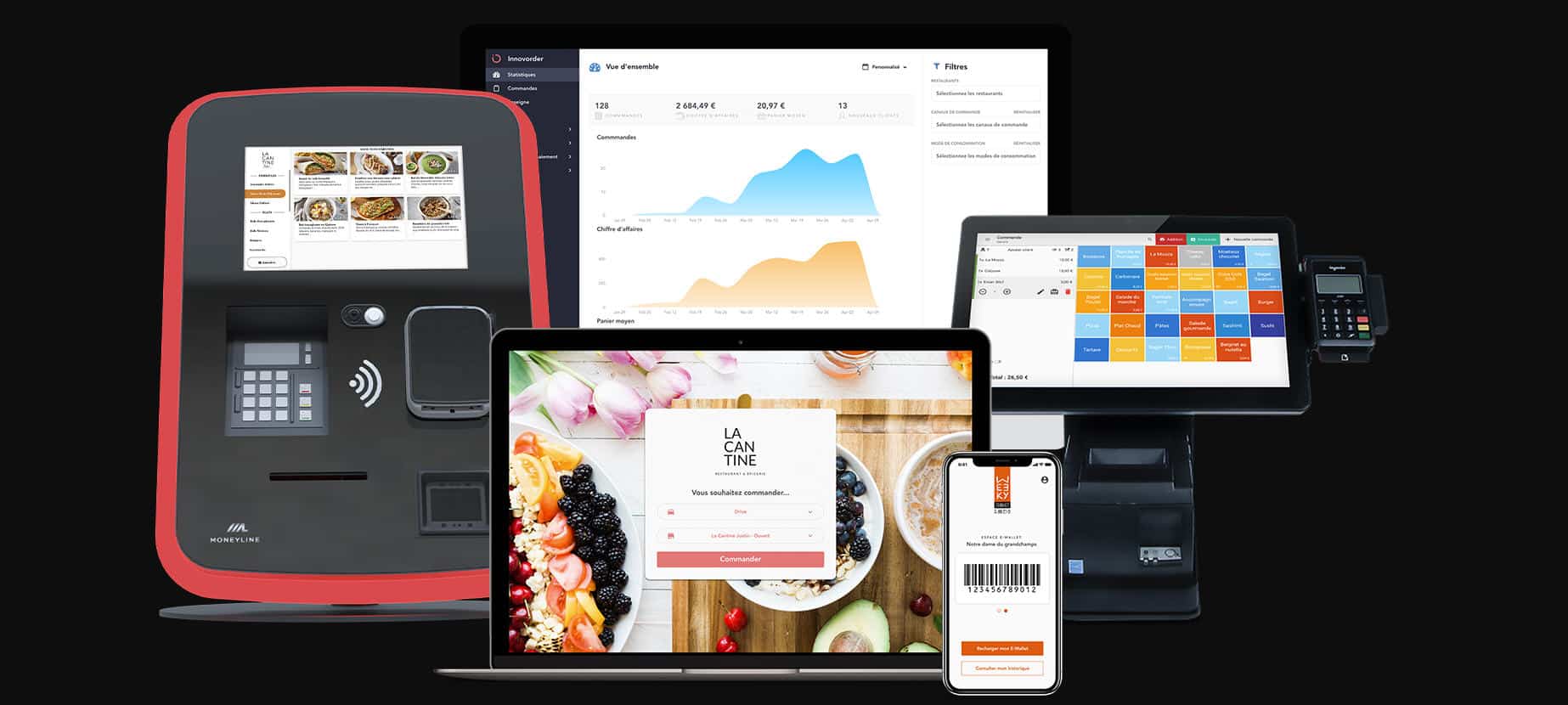Smart kiosks and Robot-chefs and waiters; do players of the restaurant industry need to embrace Big Data and Artificial Intelligence in order to remain in the game? Read our interview with Olivier Loverde, cofounder of Innovorder, who talks about current technology and how to remain competitive in the restaurant industry today.
Robots have only recently been employed in restaurants as chefs, but their presence in commercial kitchens has got the industry lit with either excitement or concern. In March 2019, CaliBurgers started using the AI-driven robot Flippy, developed by Miso Robotics, in its Pasadena location; the robot can grab and flip burger patties, handle buns and other ingredients to assemble hamburgers. CaliBurgers plans on integrating Flippy into 50 restaurants by the end of the year if all goes well.
In Boston last year, the restaurant Spyce was created specifically with the idea of integrating technology into the ecosystem in order to enhance customer experience on a low budget. Customers use the restaurant’s smart kiosks to select the elements of their meal, and the robot chefs make to order in under three minutes. To ensure quality food, the CEOs of Spyce connected with Daniel Boulud, culinary director and Michelin-star chef.
Robotics-obsessed engineers Michael Farid, Kale Rogers, Luke Schlueter and Brady Knight—otherwise known as “the Spyce Boys”—not only managed to develop the robots needed for their restaurant but they succeeded in connecting with and convincing a Michelin-star chef to invest in their company and become culinary director.
https://www.youtube.com/watch?time_continue=12&v=9LqqcDL99UA
A restaurant in Nagoya, Japan, has a similar story in terms of technology, although its robotic kitchen staff gives off more of an industrial setting. Still, the restaurant combines smart kiosks and robot chefs.
So where is the restaurant industry headed and what types of Big Data and AI-based technologies exist that are worth investing in?
Olivier Loverder, the cofounder of Innovorder, offers his thoughts on Big Data and Artificial Intelligence and how to remain competitive in the restaurant industry.
ArchiExpo e-Magazine: Tell us why restaurants are incorporating Big Data and AI-based technologies into their businesses.
Olivier Loverde: Restaurants need to have a better understanding of what’s going on inside the business. The bigger the chain, the bigger the need; this means that by using forecasting and predicting technologies, a restaurant can identify specific needs, either for a customer’s journey or internal affairs. When a client orders from a kiosk, the camera gathers details of the person using it, such as the sex type and facial expressions. Using this data, the kiosk can then provide a completely different menu, and even change the images of the products, adapting its recommended products to that specific client. This helps increase the average basket, meaning sales.
At Innovorder, we provide restaurants with a 360 solution, end-to-end, from the beginning of the customer journey to the end. It includes but is not limited to web ordering and delivery services like Deliveroo. We offer a kitchen system that acts as a to-do list for the cooks; we provide software for the customers that helps them collect the food, like with click and collect where they can follow the evolution of the meal and know when it’s ready. We’ve created a well-rounded and multi-faceted marketplace, a ready-to-go solution for restaurant industry actors that gathers data throughout the entire customer journey and analyzes the data for accurate forecasting and recommendations.

ArchiExpo e-Magazine: Can you give us a few examples of data-driven forecasting and recommendations?
Olivier Loverde: We’re able to study the movement of people inside the city. For example, when it gets too hot, customers buy healthier food like a salad; when it’s cold or raining, people buy junk food. There’s a big correlation with the weather. Also, events impact consumer habits. When the world championship took place, we noticed an increase in pizza deliveries. All of this is great in terms of data. This trend comes from the tech industry. AI leader Amazon started the trend with its data-based recommendations method for books; Netflix started by creating a contest to optimize the accuracy of the recommendations,—they provided a $1 million prize for the first-place winner. This is how it started and now it’s getting into the restaurant industry. Every chain wants to do it but they need to start with accurate recommendations.
They can do as Amazon did by profiling customers in order to find out who they are and what they want then match it with existing profiles that are similar; with this data, they can provide accurate recommendations. It’s equally important for them to forecast in order to be well prepared. What many chains are facing now is how to become data-driven by exploiting all the data they’ve collected since their opening, a time when the technology wasn’t available. They want to use their existing data, but a lot of it is either outdated and irrelevant or not clean data. Many of them want to do this and it is possible. McDonald’s, for example, bought a big data analytics company, proving the importance of integrating this technology, in order to accomplish its goal. Most of the big actors have already become data-driven. Our company works all types of actors—small, medium, large—and we’ve seen how they all want to go in this direction.
ArchiExpo e-Magazine: Any difference between small, medium and large actors?
Olivier Loverde: Interest. Bigger chains focus more on fraud analysis and detection. Their biggest concern is whether employees are stealing cash because they’re employing thousands of people with a high turnover. Small businesses will want to concentrate on forecasting, to know what’s going on for tomorrow. They need to be accurate on stock prediction to avoid wasting food. This will have social implications because, with better forecasting, we can reduce the waste of food in every restaurant chain. While the biggest demand is, of course, in the fast-food sector, traditional restaurants are also interested. In the traditional setting, it’s not about providing information to the waitress but for web-ordering. For example, let’s say a customer wishes to order food online, pay online, and show up at the restaurant to have a nice time without the worry or stress of needing to pay. The click and serve concept is becoming more interesting. We’re working with several traditional restaurants, one of which is starting to implement this concept.
Delivery services are also changing. Watch the video below of Uber Eats delivering with drones!
ArchiExpo e-Magazine: What are the limits of data prediction?
Olivier Loverde: There are many limits, actually. If you want to have something that AI and works great, you need to have clean data which is not easy to obtain. Most legacy restaurant chains that have existed for 20 to 30 years have a lot of data, but that backlog of data is outdated. The data has already evolved over time and isn’t clean or of good quality. Legal obstacles also create a challenge. Profiling customers is not freestyle. Companies need to be inside the frame of the law and customers need to approve.
It can be especially difficult integrating such technology into legacy restaurants whose architecture dates to the establishment beginning, meaning integrating new technology into old architecture. Sometimes the owner will need to rethink the entire architecture of the buildings. At Innovorder, we help clients with this by training them because our job is to help get technology into the restaurants.
ArchiExpo e-Magazine: Do you find more food services companies are looking to integrate AI?
Olivier Loverde: We’re at the beginning of AI being integrated into the restaurant industry. Although it isn’t really deep yet, big accounts like Domino’s, KFC and McDonald’s are already doing interesting things. KFC is using face recognition in China, and Domino’s created a voice recognition concept that they will perfect for better accuracy before putting it in use. The forecasting and recommendation methods have already become well-established in many restaurants. Since the restaurant industry is a low-tech market, they’ll need startups to introduce these different types of technologies.
We have seen a rise in demand for AI in the last year and a half so the trend will greatly increase by 2020. Advantages such as cutting back on waiting time, reducing food waste, increasing purchases; most industry actors want to do it. However, they want to prove that the technology is useful and the concepts are withstanding.
ArchiExpo e-Magazine: Do you agree that SMB food services leaders are unlikely to get their own hands-on AI software?
Olivier Loverde: This is not their focus or DNA. They don’t have data scientists or engineers. Even large businesses usually have an IT team but not engineers and it’s not the same thing. Very few restaurant chains have an inside team. Domino’s is considered, by the stock market, as a tech company. If you look deep into what they’re doing, they’re putting tech into the entire customer journey and internal tasks. They use a lot of data to go faster and grow.
As this kind of strategy works well, other food services leaders are trying to implement this. They can go to agencies but it’s a long term project and could take years and a lot of money. If it takes too long, it could already be obsolete. Another choice is going to a different company that already has the technology and integrate it together, but this partnership can create complications.
That’s why we decided to create a full tech platform ready to be integrated, a “ready to go” solution.
ArchiExpo e-Magazine: Will robotics play a role in the restaurant industry? How and why?
Olivier Loverde: We’re seeing a lot of robots, but it’s hard to have good quality when the product has been made by automation. I think robots are becoming necessary and there will be an increase in typologies, but the technology is evolving so fast that production should slow down this year and the next, with one or two new concepts, but there will be a larger boom in the future. It will bring a social issue, though, and it needs to be taken care of and worked on.
Robotics seems to be working well, but it’s not my area of expertise. It’s something we might consider in the future, but our focus at the moment is to become the European leader in the market.
Innovorder is growing really fast, according to Loverder, growing from 20 to 50 people within the company to an expected 100 as of next year—they’re currently recruiting, notably engineers. The showroom is in their Paris office, where they showcase company products and a representation of a fake restaurant integrating their solutions.











